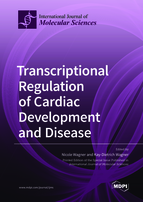Transcriptional Regulation of Cardiac Development and Disease
A special issue of International Journal of Molecular Sciences (ISSN 1422-0067). This special issue belongs to the section "Molecular Pathology, Diagnostics, and Therapeutics".
Deadline for manuscript submissions: closed (31 December 2021) | Viewed by 33659
Special Issue Editors
Interests: vessel formation in development and disease; transcriptional control; epigenetics; cardiovascular disease
Special Issues, Collections and Topics in MDPI journals
Interests: vessel formation in development and disease; transcriptional control; epigenetics; cardiovascular disease
Special Issues, Collections and Topics in MDPI journals
Special Issue Information
Dear Colleagues,
The heart is the first organ that forms and functions during embryonic development; and it must continue to work without interruption throughout one’s lifetime. In early embryonic development, the cardiac crescent contains progenitor cells of the first and second heart fields, which will develop mainly into the left ventricle/proportion of atria and the right ventricle/outflow tract/atria, respectively. The contribution of epicardial, endocardial, sinus venosus, and hematopoietic-derived cells to the heart is still controversial. Although some important transcriptional regulators of cardiac development have been identified, e.g., Gata transcription factors, Hand 1/2, TBX5, NKX2-5, MEF2, SRF, Wt1, their interactions are complex, and the transcriptional targets are not fully investigated. Many previous studies focused globally on cardiomyocyte development, but relatively little is known regarding how different cardiomyocyte subpopulations and other cells types contributing to the heart, i.e., fibroblasts, endothelial, smooth muscle, epicardial, endocardial, and immune cells, are specified.
In contrast to lower vertebrates, cardiac development is finished in mammals soon after birth, and regeneration capacity becomes extremely limited. Nevertheless, cardiomyocyte proliferation is a prerequisite for cardiac regeneration in the adult. Several transgenic mouse models with increased cardiomyocyte proliferation and improved recovery after cardiac injury have been reported. However, translation to clinical practice is limited for ethical reasons and the risk of tumor development. In zebrafish, lineage tracing studies after injury showed that newly formed cardiac cells are derived from pre-existing de-differentiating cardiomyocytes instead of a pool of cardiac progenitors. In neonatal mice, a subset of cardiomyocytes seems to be in a permissive (embryonic) state, which allows re-entry in the cell cycle and repair after injury. Thus, it would be of high interest to identify the transcriptional signature of this subset of cells to direct cardiac repair in the future.
In addition to the evident problem in stimulating cardiomyocyte proliferation for repair after injury, several additional points have to be considered. Increased cardiomyocyte repair needs additional adequate blood supply (angiogenesis) for proper cardiac function. Damaged cells must be removed by immune cells and the tissue temporarily stabilized by a fibrotic response. However, excessive or prolonged immune and fibroblast activation will result in additional damage and impaired function due to increased tissue stiffness. Thus, for efficient cardiac repair after injury, not only cardiomyocyte proliferation, but also adequate timing of angiogenesis, immune, and fibrotic response must be well orchestrated.
This Special Issue of the International Journal of Molecular Sciences will bring together the most recent advances in understanding the various aspects of the transcriptional regulation of cardiac development and disease, from basic science to applied therapeutic approaches, and will provide new insights into the complex transcriptional regulation of cardiac development, disease, regeneration, and the different cell types involved.
Dr. Nicole Wagner
Prof. Dr. Kay-Dietrich Wagner
Guest Editors
Manuscript Submission Information
Manuscripts should be submitted online at www.mdpi.com by registering and logging in to this website. Once you are registered, click here to go to the submission form. Manuscripts can be submitted until the deadline. All submissions that pass pre-check are peer-reviewed. Accepted papers will be published continuously in the journal (as soon as accepted) and will be listed together on the special issue website. Research articles, review articles as well as short communications are invited. For planned papers, a title and short abstract (about 100 words) can be sent to the Editorial Office for announcement on this website.
Submitted manuscripts should not have been published previously, nor be under consideration for publication elsewhere (except conference proceedings papers). All manuscripts are thoroughly refereed through a single-blind peer-review process. A guide for authors and other relevant information for submission of manuscripts is available on the Instructions for Authors page. International Journal of Molecular Sciences is an international peer-reviewed open access semimonthly journal published by MDPI.
Please visit the Instructions for Authors page before submitting a manuscript. There is an Article Processing Charge (APC) for publication in this open access journal. For details about the APC please see here. Submitted papers should be well formatted and use good English. Authors may use MDPI's English editing service prior to publication or during author revisions.








